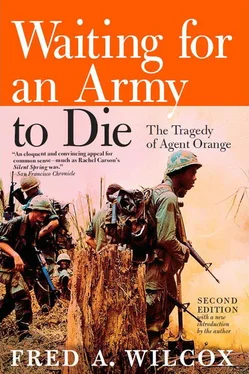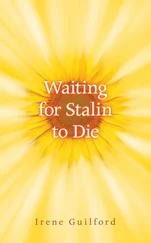To argue that the incomplete, confusing, and contradictory epidemiological information from the Seveso accident proves that dioxin has not yet been proven harmful to human beings is rather like concluding that the accident at Three Mile Island proves that nuclear power is safe. Dioxin does not enter the body like a bullet, smashing through vital organs, splintering bone, and leaving the wounded or dying person physically helpless. Sometimes its effects are felt immediately in the form of nausea, vomiting, diarrhea, dizziness, bleeding from body orifices, and in just a few days the individual appears to recover completely. This seems to have been the case for many Seveso residents, but without constant medical monitoring for elevated porphyrin levels, without liver or fat biopsies, and careful statistical comparisons of Seveso residents to Italians living in nonexposed communities, how can anyone be sure that five, ten, fifteen years from now those exposed to dioxin will not begin succumbing to a host of symptoms similar to those which have damaged the health and taken the lives of Vietnam veterans? A decade ago, when the majority of Americans had returned from Southeast Asia, the claim might easily have been made that troops exposed to phenoxy herbicides suffered no adverse effects, save an occasional upset stomach, skin rash, or headache. Today that claim has been proven tragically untrue.
On July 22, 1980, Robert O. Muller, executive director of Vietnam Veterans’ of America, told the Veterans’ Affairs Subcommittee on Medical Facilities and Benefits about a Vietnam veteran who had tried to convince the Veterans Administration that he had been exposed to Agent Orange. The veteran had rashes on his legs and other symptoms of dioxin exposure, including recurring migraine headaches, severe chest pains, and respiratory problems. But the only treatment he had received from the VA was three and a half weeks in the psychiatric ward, and prescriptions for Valium, lithium, and sleeping pills. Unable to cope with being told that his chronic medical problems were psychiatric in nature, or with the apparent indifference of the nation for which he had fought, the veteran sent his wife and children away for the weekend and, said Muller, “put the VA prescribed pills to their final use.” Muller, whose spine was shattered by a bullet in Vietnam, concluded his testimony as follows: “Mr. Chairman, there is, and has been, human evidence on the health impact of exposure to 2,4,5-T. Now, finally, the public recognizes that the evidence exists.
“That recognition allows us to push past the meaningless threshold debates to the fundamental questions. It allows us to stop saying, vacuously, that we need more evidence; and to start asking the serious questions: precisely how much evidence, and precisely what type of evidence, do we need?
“The VA’s answer to this question is becoming regrettably clear. They are waiting for something like absolute certainty. The VA’s theory of some fundamental biological distinction between Vietnam veterans and the rest of the human race is, of course, laughable. But it is, unfortunately, only the final implication of the VA’s underlying quest for absolute certainty. But what is this ‘certainty’? What does it require? More importantly, is the VA’s ‘certainty’ achievable at all?” 18
Although he was speaking on behalf of his fellow Vietnam veterans, the answer to Muller’s questions, provided answers are forthcoming, will have profound implications for people throughout the industrialized world. How many studies of the effects of dioxin on rats, mice, monkeys, and guinea pigs must be done before scientists are able, or willing, to extrapolate from the results of these experiments the effects that dioxin might have on human beings? If human beings are so biologically distinct from other animals, then why bother researching the effects of dioxin at all? Why not just concede that no matter how much “anecdotal evidence” indicates a connection between dioxin and the suffering and death of human beings, there will never be “conclusive” evidence—because human beings are not rhesus monkeys or rats or mice. [21] It is interesting that other substances, including the artificial sweeteners, cyclamates, have been banned under the Federal Food, Drug and Cosmetic Act on the basis of studies showing they were carcinogenic in animals. And although scientists know less about the effects of formaldehyde than the components of Agent Orange on human health, at least three federal agencies have proposed regulating formaldehyde, while the Consumer Product Safety Commission believes it should be banned in certain home products.
According to the Environmental Defense Fund, “the American population as a whole is Dow’s guinea pig and the environment is Dow’s laboratory…” But in spite of Eriksson and Hardell’s studies of Swedish workers, warnings from the World Health Organization about the toxicity of dioxin, and outbreaks of chloracne among its own workers, Dow Chemical continues to manufacture and market a product that its own scientists have admitted contains an animal carcinogen, and residuals of which Dow’s scientists have discovered in beeff at from cattle grazed on rangelands where 2,4,5-T was sprayed. Dow’s argument for continuing the company’s crusade to keep this particular herbicide on the market is based, according to company spokesmen, not so much on profit as on principle . “We think,” said one Dow spokesperson, “that 2,4,5-T is a very important symbol. If we were to lose on this issue, it would mean that American public customs would be beaten back a couple hundred years to an era of witch hunting. Only this time the witches would be chemicals, not people, and that’s the importance of this issue.” 19
Today we are living in a laboratory where the cancer victim must prove that his or her illness is the “direct result” of having been exposed to one of the many toxic chemicals that are spewn into our air and water, sprayed upon our food and forests, and that inundate many of the places where we work. In the name of science we seem to have banished common sense to the dustbin of “anecdotal evidence,” allowing multinational chemical companies to tamper dangerously with the ecology of our planet and the health of future generations.
Vietnam veterans came home believing they could eventually forget the horrors of guerilla warfare and live long and productive lives. Unfortunately, for thousands of veterans the past decade has been the latency period during which dioxin would begin to slowly and then more rapidly attack their enzyme systems, damage their livers, weaken their hearts, and induce various types of cancers that would eventually destroy their young bodies. Yet it would appear that, more than three decades after 2,4,5-T and 2,4-D were first developed and marketed for commercial use and twenty years after the first defoliation mission, no institutes will be established to house scientists who might wish to examine the effects of herbicides on human health. Nor have any chairs been endowed at universities for the study of TCDD-dioxin on human beings, and it appears that no agency comparable to NASA will be funded to pay the salaries of the world’s best scientific minds while they seek to discover just what is responsible for the maiming and killing of thousands of veterans.
“One need only to look toward the efforts of the National Cancer Institute, and its Asbestos Information Program, or the American Cancer Society and its information on smoking, or the diethylstilbestrol programs that exist nationwide.” Dr. Jeanne Stellman, associate professor of public health at Columbia University, told the Veterans’ Affairs Committee of the House of Representatives, “to see what can be done if the national will, energy, and commitment are present. Surely our veterans and their service organizations, the people who served our nation at the peril of their lives, they and their families deserve the finest in research, in outreach, in information, in medical care that our country can put forth. Only minimal effort has thus far been forthcoming.” 20
Читать дальше











